The Ultimate Creamy Roasted Tomato Soup Recipe (Vegan & Gluten-Free)
Do you find yourself with an abundance of luscious, ripe tomatoes from your garden or the farmers’ market? There’s no better way to celebrate their natural sweetness and vibrant flavor than by transforming them into this incredible Roasted Tomato Soup Recipe! This homemade soup isn’t just a meal; it’s a comforting experience. With every spoonful, you’ll savor a creamy, deeply savory concoction bursting with the irresistible taste of perfectly roasted tomatoes and mellow garlic. It’s a delightful, wholesome dish that the entire family will adore, effortlessly fitting into a healthy lifestyle as it’s naturally gluten-free and completely vegan.

This post is sponsored by Nature’s Charm. All text and opinions are my own.
Forget the canned versions – making tomato soup from scratch, especially by roasting the vegetables, elevates the flavor to an entirely new level. The roasting process caramelizes the natural sugars in the tomatoes and onions, transforming them into a rich, complex base that forms the soul of this velvety soup. It’s surprisingly simple to prepare, requiring minimal effort for results that taste incredibly gourmet. Whether you’re looking for a light yet satisfying lunch, a heartwarming appetizer, or a fulfilling dinner paired with your favorite sandwich, this creamy roasted tomato soup is a recipe you’ll want to keep on repeat.
Ingredients for the Perfect Roasted Tomato Soup
This exquisite vegan tomato soup recipe is crafted using a handful of fresh, easy-to-find, whole-food ingredients. Each component plays a vital role in building the incredible depth and flavor of the soup. Here’s a detailed look at what you will need to gather:
- Fresh Tomatoes (3 pounds) – The star of our show! I highly recommend and prefer using ripe Roma tomatoes for their meaty texture and lower water content, which contributes to a richer, less watery soup. However, nearly any variety of fresh, ripe red tomatoes will work wonderfully. Beefsteak, slicing, or even a colorful mix of cherry or heirloom tomatoes are all excellent alternatives that can add their unique nuances of sweetness and acidity. The key is to select tomatoes that are at their peak ripeness for the most vibrant flavor.
- Yellow Onions (2 medium) – Peeled and cut into quarters, yellow onions are perfect for roasting. They caramelize beautifully in the oven, developing a profound sweetness and a foundational depth of flavor that perfectly complements the tartness of the tomatoes. As they roast, they become incredibly tender and sweet, effortlessly blending into the soup.
- Garlic (1 whole bulb) – Fresh garlic, roasted gently in its papery skin, undergoes a magical transformation. Its pungent raw flavor softens into a sweet, mellow, and almost buttery richness. This process infuses the soup with an irresistible aromatic depth that is a cornerstone of its deliciousness. Simply slice the entire bulb in half horizontally to expose the cloves before preparing it for roasting.
- Olive Oil (3 tablespoons) – A good quality extra virgin olive oil is indispensable for two main reasons. Firstly, it coats the vegetables, facilitating their glorious caramelization during roasting and helping to draw out their natural sugars. Secondly, it forms a savory, rich base for the soup, binding all the flavors together and contributing to a luxurious mouthfeel.
- Italian Seasoning (2 teaspoons) – This classic blend of dried herbs, typically comprising oregano, basil, thyme, and rosemary, imparts a delicate yet unmistakable Italian essence to the soup. It harmonizes wonderfully with the natural flavors of the roasted tomatoes and the fresh basil you’ll add later, creating a comforting, familiar taste.
- Vegetable Broth (2 cups) – This provides the liquid base for your soup. Choose a high-quality vegetable broth whose flavor you genuinely enjoy, as it will be a prominent taste in the finished product. Opting for a low-sodium variety allows you to have more control over the final salt content of your soup.
- Full-Fat Coconut Milk (½ cup) – This is the “secret ingredient” that bestows a wonderfully creamy, luscious texture upon our roasted tomato soup, all without any dairy. Full-fat canned coconut milk is highly recommended for achieving the richest, most velvety finish, mirroring the indulgent mouthfeel of traditional cream-based soups or bisques. If you’re concerned about a coconut flavor, rest assured – the robust flavors of roasted tomato and garlic largely mask it, leaving behind only a luxurious, creamy sensation. Chef’s Choice is a brand often chosen for its superior quality and creaminess.
- Fresh Basil (1 bunch) – A generous handful of fresh basil is absolutely essential for creating that iconic, vibrant tomato basil soup flavor. Added towards the end, its aromatic freshness brightens the deep, roasted notes, providing a beautiful contrast and a burst of herbaceousness.
- Salt and Pepper (to taste) – These essential seasonings are crucial for enhancing and balancing the flavors of the soup. Salt brings out the natural sweetness and savory notes of all the ingredients, while freshly ground black pepper adds a subtle warmth and a light “zip” that rounds out the overall taste profile.
- Optional Enhancements: For an extra layer of flavor complexity, consider adding a splash of balsamic vinegar to the vegetables before roasting, a pinch of red pepper flakes for a subtle kick, or even a dash of nutritional yeast for an added cheesy, umami depth.
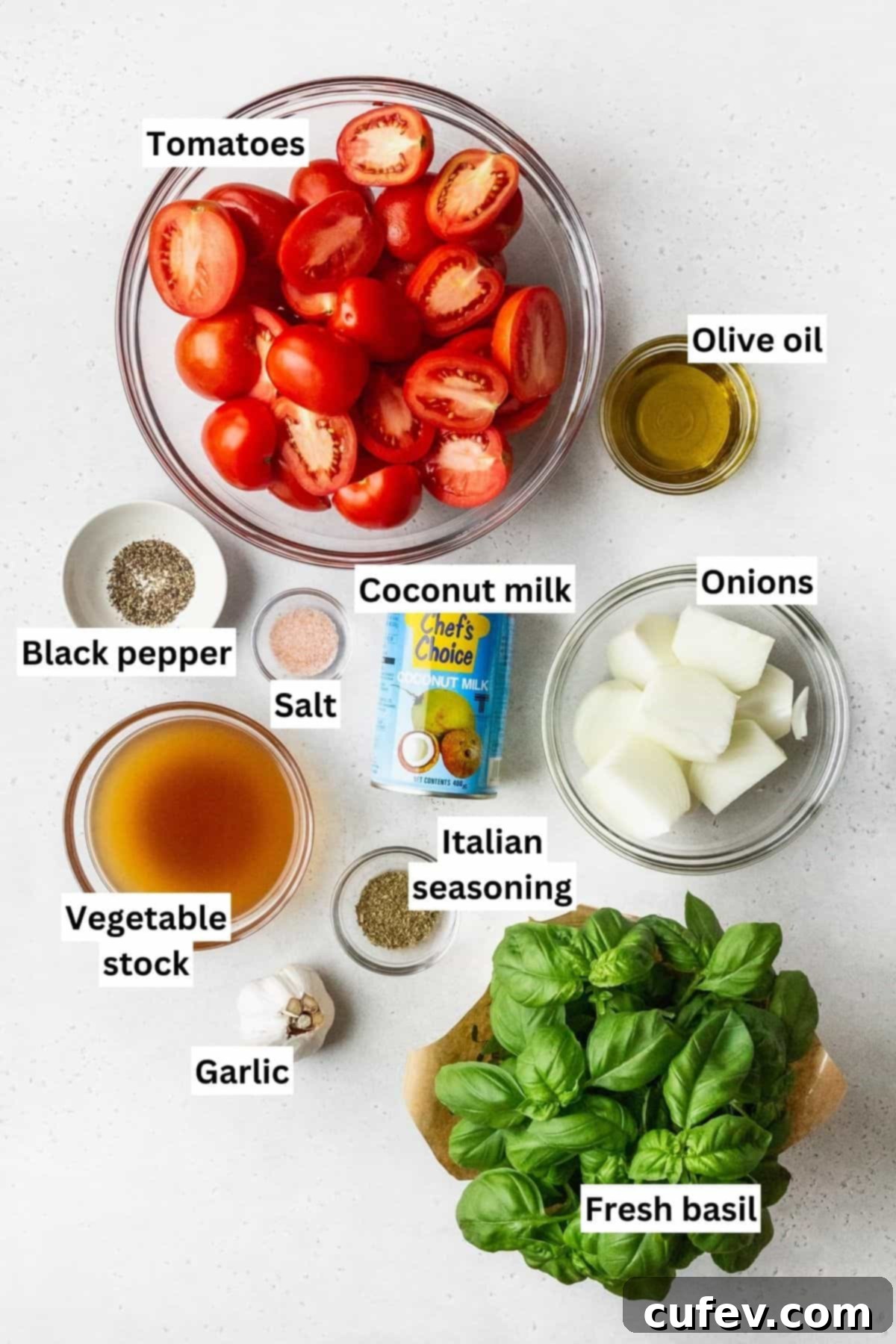
How to Make Homemade Roasted Tomato Soup: A Step-by-Step Guide
The preparation for this creamy, dreamy vegan tomato soup is surprisingly straightforward, yet the results are incredibly comforting, rich, and deeply satisfying. Roasting the vegetables is the key to unlocking their most intense and delicious flavors. Here’s how to make this culinary masterpiece:
Step 1: Preheat the Oven. Begin by preheating your oven to a robust 425°F (218°C). This high temperature is crucial for achieving proper caramelization on your vegetables, ensuring they roast rather than steam, thereby maximizing their flavor development from the moment they enter the oven.
Step 2: Prepare the Roasted Garlic. Take the whole garlic bulb and slice it horizontally across the middle, exposing the individual cloves within. Place the cut halves, exposed-clove side up, on a small piece of aluminum foil. Drizzle generously with olive oil and sprinkle with a pinch of salt and pepper. Gently reassemble the garlic bulb by putting the two halves back together, then tightly wrap the entire bulb with the foil. Roasting the garlic this way allows it to soften and sweeten, developing a deep, nutty, and wonderfully mellow flavor that is a stark contrast to the pungent raw garlic. This sweet roasted garlic will be a foundational flavor in your finished soup.
Step 3: Prepare and Season the Remaining Vegetables. While your oven heats, wash and halve your fresh tomatoes. Peel the yellow onions and cut them into quarters. Arrange the halved tomatoes (you can place them cut-side up for a milder roast or cut-side down for more caramelization) and quartered onions on a large baking sheet. It’s important to ensure they are in a single layer to promote even roasting and prevent overcrowding, which can lead to steaming. Drizzle the vegetables generously with the remaining olive oil, then sprinkle evenly with salt, pepper, and the Italian seasoning. Use your hands to toss everything together directly on the baking sheet, ensuring all the vegetables are thoroughly coated in the oil and seasonings. This step is crucial for developing those irresistible roasted flavors.
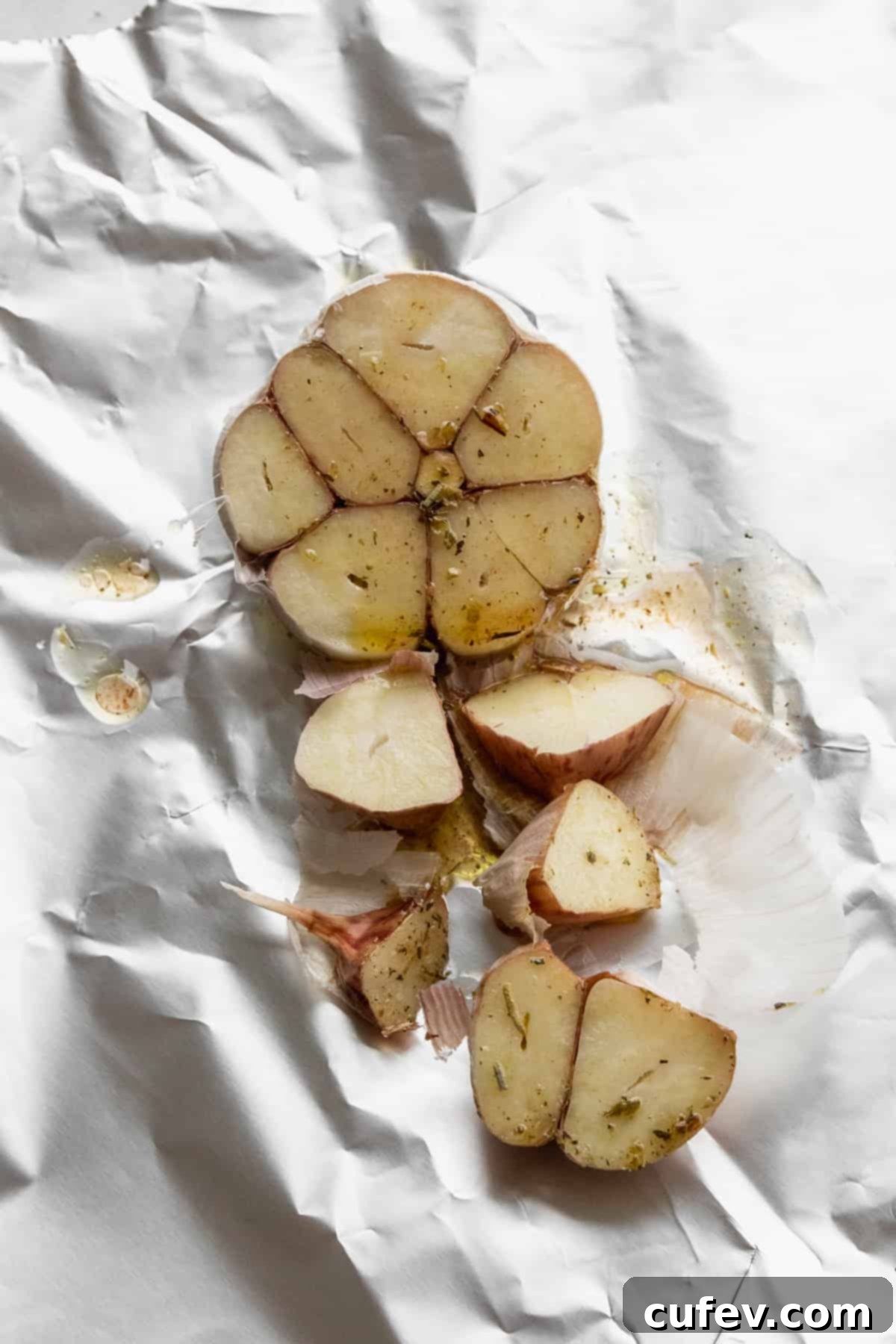

Step 4: Roast the Vegetables. Carefully place the baking sheet with the seasoned tomatoes and onions, along with the foil-wrapped garlic bulb, into your preheated oven. Roast for 1 hour. During this crucial hour, the vegetables will undergo a magnificent transformation: they will soften, sweeten, and develop beautiful caramelization around their edges. This roasting process intensifies their natural flavors, resulting in a soup that is incredibly rich, savory, and complex. You’ll know they’re perfectly roasted when the tomatoes are slightly shriveled and browned, and the onions are tender, translucent, and deeply caramelized.


Step 5: Blend the Soup Base. Once the vegetables are perfectly roasted, carefully transfer all of them from the baking sheet into a large pot or a sturdy Dutch oven. Unwrap the foil from the roasted garlic bulb and gently squeeze the soft, buttery garlic cloves directly into the pot, leaving behind the papery skins. Pour in the vegetable broth and add the fresh basil. Using an immersion blender, blend the ingredients directly in the pot until the soup is completely smooth and creamy. If you don’t have an immersion blender, you can transfer the mixture in batches to a high-powered stand blender (please refer to our success tips below for safe blending of hot liquids).
Step 6: Simmer for Flavor Melding. After blending, turn the heat to medium and bring the soup to a gentle simmer. Allow it to simmer for 5-10 minutes. This simmering period is essential, as it allows all the beautiful roasted flavors to meld together and deepen, creating a more cohesive, harmonious, and truly delicious soup.
Step 7: Finish and Serve. Finally, stir in the full-fat coconut milk. Continue to cook for another 3-4 minutes, allowing the coconut milk to fully incorporate and gently warm through. It’s important not to bring the soup to a rolling boil after adding the coconut milk, as this can sometimes cause it to separate. Taste the soup and adjust seasonings as needed – perhaps a little more salt, pepper, or even a tiny pinch of sugar if your tomatoes were particularly acidic. Serve hot, garnished with extra fresh basil, a swirl of good olive oil, or your favorite croutons for an added touch of elegance and flavor!
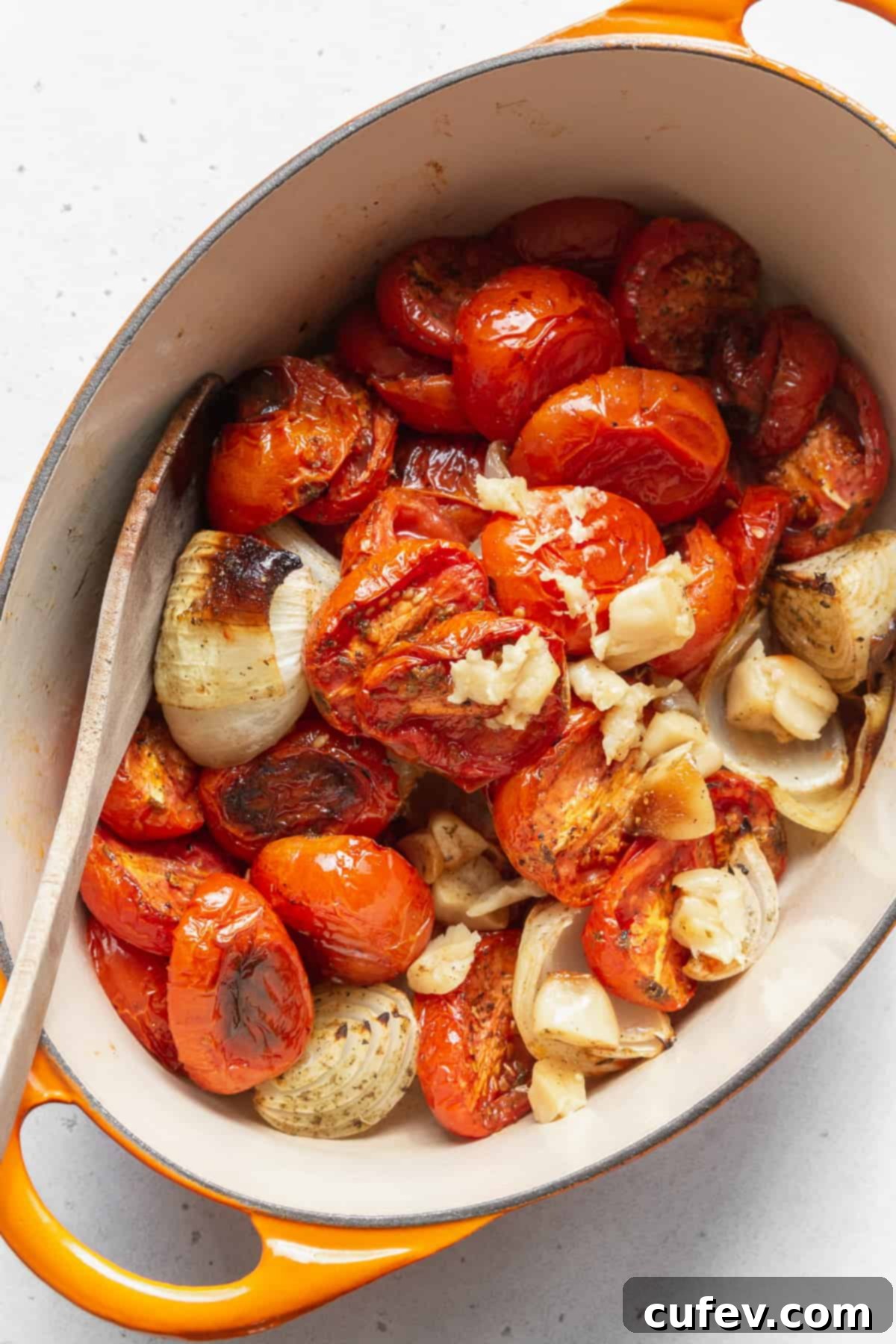
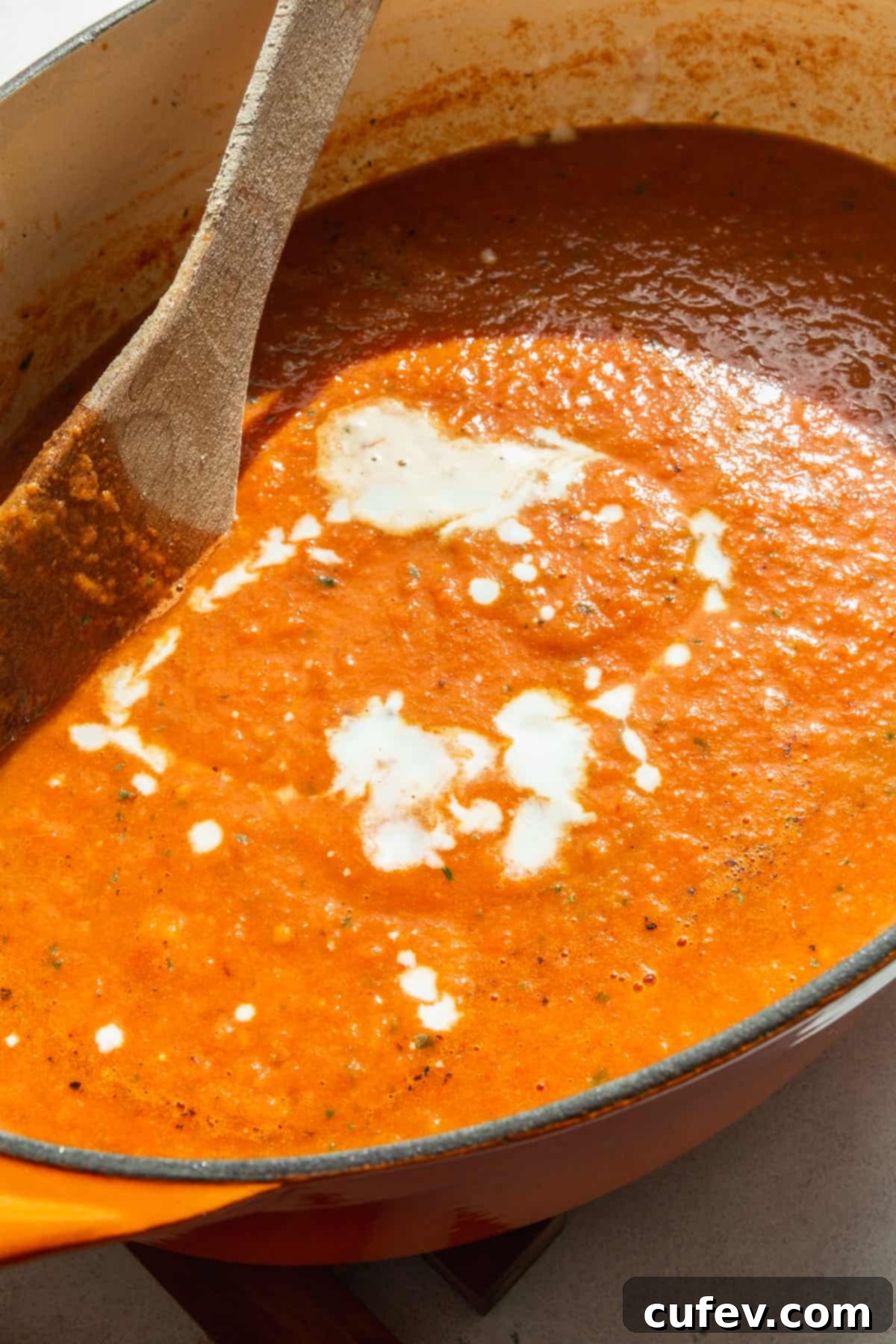
Roasted Tomato Soup Success Tips & Tricks
Achieving the perfect bowl of creamy roasted tomato soup is easy with these helpful tips and tricks. Follow these guidelines to ensure your soup is bursting with flavor and boasts a wonderfully smooth texture every time:
- Choose the Right Tomatoes for Peak Flavor: The quality of your tomatoes is paramount to the flavor of your soup. Always opt for ripe, in-season tomatoes whenever possible, as they offer the most natural sweetness and depth. Farmers’ markets are excellent sources for finding peak-season produce. Roma tomatoes are often recommended for their lower water content and meaty flesh, which contributes to a naturally richer, less diluted soup. However, don’t hesitate to experiment with a mix of varieties – beefsteak, heirloom, or even sweet cherry tomatoes can add wonderful layers of flavor and sweetness to your roasted blend.
- Prevent Burnt Onions During Roasting: While a little char on the roasted vegetables adds a delightful depth and smokiness, truly burnt onions can impart an unpleasant bitter taste that will affect the entire soup. It’s important to keep a watchful eye on your onions during the roasting process, especially around the halfway mark (after about 30 minutes). If you notice them browning too quickly or becoming excessively dark, you can gently stir them to promote even cooking or strategically cover parts of the baking sheet with aluminum foil to protect them from further direct heat. The ultimate goal is beautiful caramelization, not incineration!
- Immersion Blender Alternatives for a Smooth Finish: An immersion blender is incredibly convenient as it allows you to purée the soup directly in the pot, minimizing cleanup. However, if you don’t own one, a high-powered standard blender works just as well. When using a standard blender for hot liquids, always work in small batches. Fill the blender jar only about halfway to avoid overfilling. Crucially, remove the center cap from the blender lid (the small, removable piece) and cover the opening with a clean kitchen towel. This allows steam to escape, preventing dangerous pressure buildup that could cause the lid to blow off and splatter hot soup. Blend until silky smooth, then transfer to a separate bowl before blending the next batch.
- Option: Leave the Soup Chunky. While this recipe aims for a beautifully smooth and creamy soup, you can easily adapt it if you prefer a chunkier, more rustic homemade tomato soup. To achieve this, simply blend the soup only partially, leaving some of the tender roasted tomato and onion chunks intact. If you’re using a standard blender, pulse the soup a few times until you reach your desired texture, rather than running the blender at a steady, continuous speed. For an even chunkier result, you can reserve about a quarter of the roasted vegetables before blending the rest, then stir them back into the puréed soup.
- Option: Make it Spicy. For those who enjoy a bit of heat to complement the sweetness of the tomatoes, adding spice is simple and effective. You can stir in ¼ to ½ teaspoon of dried red pepper chili flakes to the tomato and onion seasoning mixture before roasting. For a deeper, smoky heat, consider roasting a deseeded jalapeño or a small poblano pepper alongside your other vegetables. The roasted pepper will add both flavor and a pleasant warmth.
- Option: Serve it with Classic Pairings and Beyond. Tomato soup and grilled cheese is a classic combo that simply can’t be beaten! Elevate your grilled cheese by experimenting with different types of cheese (like smoked gouda, sharp cheddar, or provolone) and artisanal breads. For a fun twist, you can cut up your grilled cheese sandwich into bite-sized chunks and use them as delightful “croutons” on top of your soup. Beyond grilled cheese, consider serving this vibrant soup with crispy garlic bread, homemade cornbread croutons, fresh cheese arepas, or even a flavorful arepa Reina Pepiada. A swirl of vegan pesto or a sprinkle of fresh herbs also makes a beautiful and tasty garnish.
- Adjust Acidity for Perfect Balance: Roasting tomatoes naturally mellows their acidity, but sometimes, depending on the ripeness and variety of the tomatoes, the soup can still taste a bit tart or sour. If you find your roasted tomato soup a little too acidic for your liking, there are easy remedies. A small pinch of sugar (start with ½ teaspoon and add more if needed) can help balance the flavors without making the soup overly sweet. Alternatively, a tiny amount of baking soda (about ¼ teaspoon) can effectively neutralize acidity. Stir well and taste after each adjustment until you reach your perfect flavor balance.
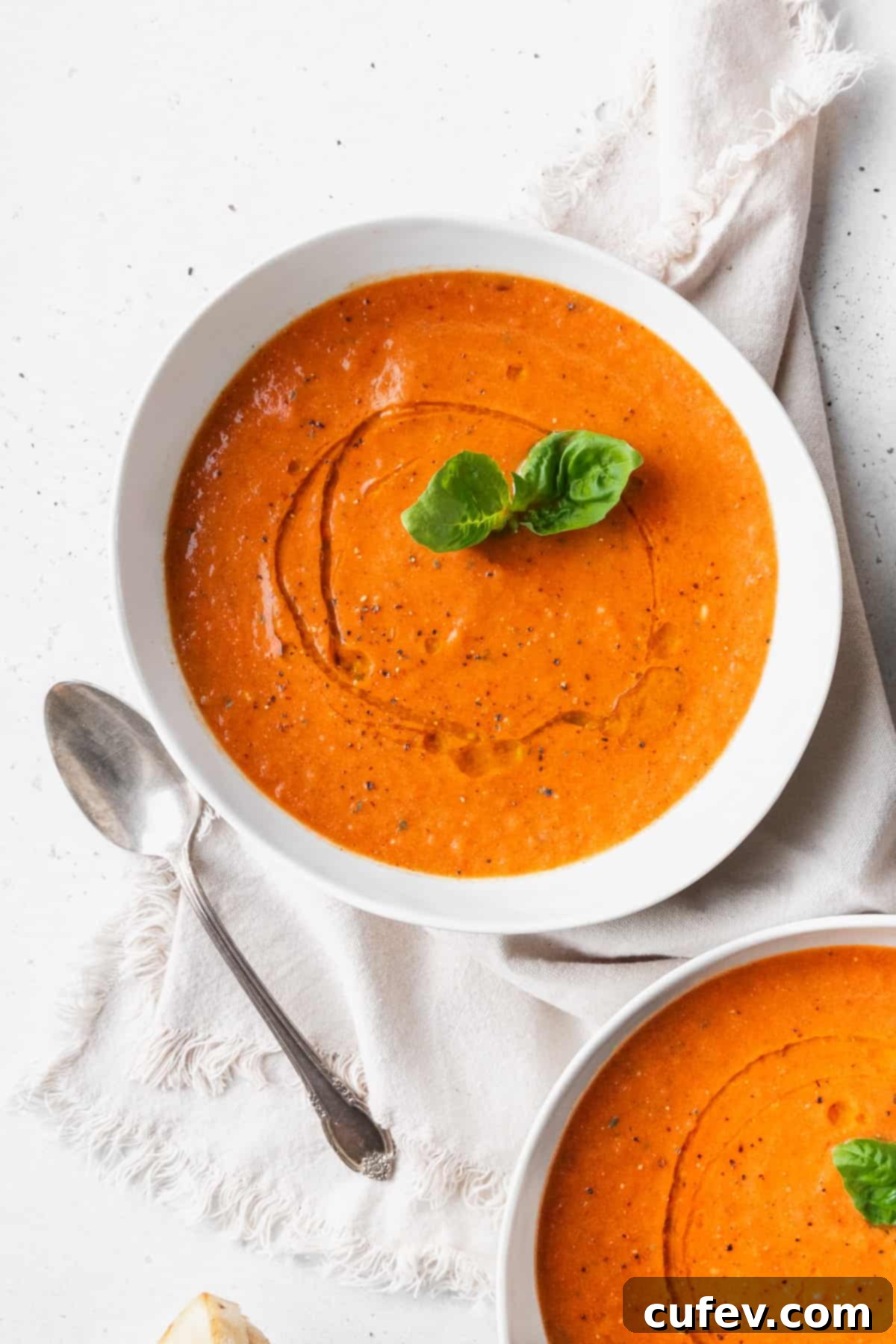
Frequently Asked Questions About Roasted Tomato Soup
Generally, no, peeling tomatoes for soup is not necessary, especially for a roasted soup like this one. The roasting process softens the skins significantly, and a high-powered blender will typically purée them into a smooth consistency without any noticeable texture. Leaving the skins on also preserves valuable nutrients and fiber, contributing to a healthier soup. However, if you’re aiming for an absolutely ultra-silky, restaurant-quality smooth soup, you can peel them. The easiest way to do this is *after* roasting; the skins will slip off much more easily with a gentle rub.
Without a doubt, roasting tomatoes in the oven is far superior for soup, particularly for enhancing their flavor. Roasting caramelizes the natural sugars in the tomatoes and onions, intensifying their sweetness and creating a rich, complex depth that boiling simply cannot achieve. This method also naturally reduces their acidity. If, despite roasting, your soup still tastes a little sour, a small amount of sugar (start with a teaspoon and adjust) or a tiny pinch of baking soda can easily balance the flavors. This roasting step is truly what elevates this homemade tomato soup from good to extraordinary, giving it a profound, gourmet taste.
There are numerous excellent non-dairy alternatives that can provide a wonderful creamy texture to soups, making them suitable for vegan or dairy-free diets. My top recommendation for this recipe is full-fat coconut milk due to its richness and remarkable ability to mimic heavy cream. Other fantastic options include coconut cream (which is even thicker and richer than milk), raw soaked cashews blended into a smooth paste (known as cashew cream), various non-dairy milks like oat milk or soy milk (though they might offer less richness than coconut products), or even evaporated oat milk for a condensed, creamy effect. Each option offers a slightly different flavor and texture profile, but all can achieve a delightful creaminess.
Traditionally, a bisque is a rich, creamy, and often puréed soup, commonly made with seafood (like lobster bisque) and typically thickened with cream and rice. Soups, on the other hand, are a much broader culinary category and can be clear, brothy, chunky, or creamy, with a vast range of textures and ingredients. The key distinction often lies in the luxurious richness and the method of thickening. Because this recipe uses a creamy element (full-fat coconut milk) and results in a velvety smooth, puréed texture, it technically falls under the description of a dairy-free tomato bisque, offering a luxurious mouthfeel akin to its traditional counterparts.
While fresh, ripe tomatoes are highly recommended for achieving the most vibrant and nuanced flavor in this roasted tomato soup, you can certainly adapt the recipe using canned tomatoes if fresh ones are out of season or unavailable. For a comparable amount, use two (28-ounce) cans of whole peeled tomatoes, drained. You would still roast them along with the onions and garlic to develop some caramelization and depth, but be aware that the flavor might not be as bright or complex as that achieved with truly fresh, ripe, in-season tomatoes. It’s a convenient and still delicious alternative in a pinch!
Several factors can contribute to bitterness or excessive acidity in your homemade tomato soup. Bitterness often stems from using under-ripe tomatoes, overcooking or burning the onions during the roasting process, or sometimes from certain types of vegetable broth. Acidity is a common characteristic of tomatoes, especially if they aren’t fully ripe when picked. To remedy this, ensure you always use ripe tomatoes, monitor your onions carefully during roasting, and if the soup still tastes too acidic, a small pinch of baking soda (about ¼ teaspoon at a time) can help neutralize the acidity. Alternatively, a teaspoon of sugar can balance the flavors. Stir well and taste after each adjustment until you achieve your perfect, harmonious balance.
Storage Directions for Your Delicious Soup
Enjoying your homemade roasted tomato soup doesn’t have to be a one-time event! This recipe is excellent for meal prepping or saving for later. Here’s how to properly store and reheat your leftovers:
- Refrigeration: Leftover roasted tomato soup can be stored covered in an airtight container in the refrigerator for 4-5 days. Ensure the soup has cooled completely before transferring it to the container.
- Freezing: This soup freezes beautifully! You can store it in a freezer-safe container or freezer bags for up to 3 months. For individual portions, consider freezing it in smaller containers or even silicone muffin tins (then transfer the frozen pucks to a bag). To reheat, defrost the soup in the refrigerator for 8-12 hours or overnight before warming.
- Reheating: To reheat your soup, simply transfer it to a saucepan over low to medium-low heat. Stir occasionally to ensure even heating and prevent sticking, continuing until the soup is thoroughly warmed through and bubbling gently. If the soup appears too thick after refrigeration or freezing, you can add a splash of vegetable broth or water to achieve your desired consistency.

More Delightful Soup Recipes to Explore
If you loved this creamy roasted tomato soup, you’re in for a treat! Here are a few more incredible soup recipes to warm your soul and tantalize your taste buds:
- Love creamy soup? This creamy vegan pumpkin soup is the perfect meal when you’re feeling a little lazy because it comes together in just 30 minutes with mostly pantry ingredients! Another fantastic creamy option is this satisfying gluten-free potato soup recipe.
- If you’re looking for something with a spicy kick and a burst of unique flavor, this comforting Korean kimchi soup (kimchi tteokguk) is incredibly flavorful and is guaranteed to warm you up from the inside out.
- Do you want to up your crouton game and add an extra layer of deliciousness to your soups? Ditch your plain Jane store-bought croutons for these absolutely delightful homemade cornbread croutons! They’re a game-changer!
Thanks so much for stopping by and taking the time to discover this incredible roasted tomato soup recipe! I truly hope you loved making and tasting it as much as I do. For even more mouth-watering dairy-free, gluten-free, and/or vegan dessert inspiration, delicious main courses, and handy kitchen tips, make sure to follow me on Pinterest, Facebook, and Instagram. You can also get all of my newest content, including exclusive recipes and updates, delivered straight to your inbox by signing up for my email newsletter — I promise not to spam you! Happy cooking!

Roasted Tomato Soup Recipe
Print
Pin
Rate
Ingredients
- 3 lbs roma tomatoes
- 2 medium yellow onions
- 1 whole garlic bulb
- 3 tablespoons olive oil
- 1 teaspoon fine salt
- ½ teaspoon black pepper
- 2 teaspoons Italian seasoning
- 2 cup vegetable broth
- ½ cup Chef’s Choice coconut milk
- 1 bunch fresh basil
Instructions
-
Preheat the oven to 425°F (218°C).
-
Cut the garlic in half horizontally without peeling it. Open it on a piece of aluminum foil, drizzle on some olive oil, and sprinkle on some salt and pepper. Put the garlic back together and tightly wrap the entire bulb with the foil.
-
Cut the tomatoes in half, cut the peeled onions into quarters, and add all the vegetables to a baking sheet and toss them with olive oil, salt, pepper, and Italian seasoning.
-
Bake the vegetables and the foil-wrapped garlic in the preheated oven for 1 hour.
-
Add all the roasted vegetables, and squeeze out the garlic cloves into a pot with the vegetable broth and fresh basil. Use an immersion blender to purée the ingredients.
-
Turn the heat to medium and simmer the soup for 5-10 minutes.
-
Stir in the coconut milk and cook for another 3-4 minutes. Taste for seasoning and serve hot!
Notes
- Refrigeration: Leftover tomato soup keeps covered in an airtight container in the refrigerator for 4-5 days.
- Freezing: The soup can also be frozen in a freezer-safe container for up to 3 months. Defrost the soup in the refrigerator for 8-12 hours before reheating.
- Reheating: Warm the soup in a saucepan over low heat, stirring occasionally until heated through.
